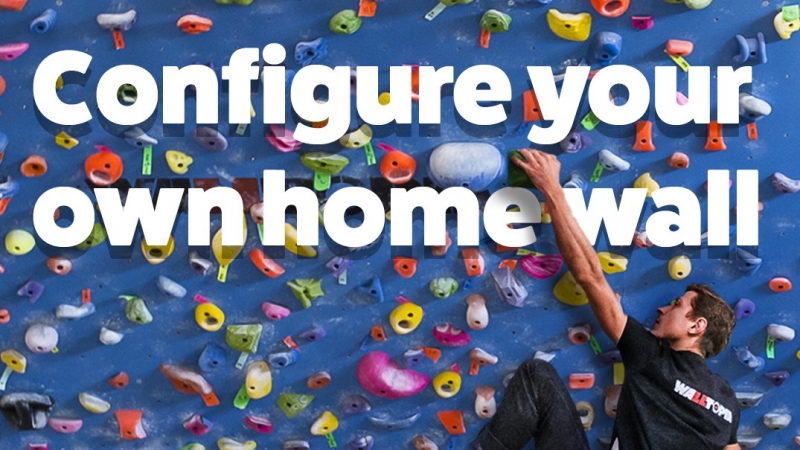Setting Up a Home Climbing Station, the Walltopia Way

Until recently the wish for setting up a home climbing station was rooted in a desire to get better at climbing in addition to the membership in a local gym. It was good-to-have, or even a luxury to some. A space for training and having your climbing friends over too. Now it is different.
To many avid climbers around the globe, setting up a home climbing wall station today is the only way to keep climbing, at least for a while. Sure, the experience cannot really make up for what a gym offers and we know that first hand, designing and building climbing gyms since 1998. Still, having a home climbing wall will not just keep you sane in those challenging times but will also help you build a routine that will support your climbing performance once the world goes back to normal (sooner than later, we hope).
So, thinking about what we can do for the climbing community as the world leader in the industry, we decided to make our first product line for climbers. If having your own climbing wall has been an idea that has been with you for a while already, read on to learn the steps to make it real with Walltopia. The easiest, fastest, and safest way, we claim.
Step 1: THE SEARCH FOR A PERFECT SPACE
There is rarely a perfect space for a climbing wall once a home is built. So the first step is to evaluate what you have and decide on what will serve best the purpose with minimum need of compromises. For some that will be utilizing a large space in the dining room, for others – the garage or the basement. Think not only about the wall, but also how would you attach it, would there be enough space for falls, can the space accommodate a couple of friends too, or, if you have little kids, can you easily limit the access to the wall. Once you check all those questions (and some more – lights, electricity, storage for holds….), you are ready for step two.
Step 2: DESIGN YOUR DREAM CLIMBING WALL
To do that, you start by taking measures of the space – its height and the desired width (over the whole wall or just a section of it). Once you have those and decide to trust Walltopia for your home wall, the overall design and all the important features you have to think of, can be done in less than 10 minutes. Seriously, all you have to do is follow the steps in our configurator.
Based on our industry expertise and all the inquiries we get for home walls, we have developed pre-designed and engineered options for a 7.5 sqm. to 12 sqm. of climbing surface (80 – 130 sq.ft.). Panels are made of strong 18mm birch plywood surfaced with a special coating of six layers of polyester resin – the same you might have climbed on in some of the gyms we have built. They also come with pre-installed T-nuts at a density of 36 pcs per sqm.
Once you choose your wall size, it’s time for the creative touch – what color would you like it to be. Although we’re huge fans of plain white or grey panels, we find the natural wood fitting pretty neat in a home environment and bringing a cozy feeling. You have all three to choose from.
Then it’s time for the choice of texture. Chances are you’ll go for panels with balanced friction that enhances the experience and makes it feel very real to what you have in a gym. Still, if you have something else in mind or you expect your kids to get excited about climbing too, you may choose panels with no friction. Figuring out the basis of your wall, the form will also get you through a choice of structure (when needed), preferred angle (0° – 30°), fasteners.
Step 3: IN SEARCH OF THE RIGHT HOLDS VARIETY
As we have lots of knowledge in preparing holds selection too, we curated three packages that would be good for a start. If route setting excites you though, you can browse through Holdtopia and make your own climbing holds selection that will be sent with your wall. Think of a balanced variety in size and grip and preferred texture.
Step 4: SAFETY
There are a few important factors that will assure the safety of your climbing.
First – the wall. If you’ve decided to trust us for producing your wall, all calculations you should take care of would be made from us and we will also send you a detailed DIY manual with any steps of the assembling.
The second most important thing is to build a habit of maintaining the wall right (such as tightening and inspecting the holds, t-nuts, joints, etc.).
The third is to secure yourself safe falls – enough space + good padding. Our choice for padding is Climbmat’s two-layer mat, wrapped in a vinyl case for maximum durability. We recommend a 2 x 2 m (6.5 x 6.5 ft) or 1.5 x 1.5 m (5 x 5 ft) option.
Last, you should decide whether you need or no measures to prevent free access to the wall (if some curious little climbers may get interested in it).
Step 5: NICE-TO-HAVEs
Building a home climbing wall is building a space you’d love spending time in. That means it will get better over time and will evolve with your climbing. Although so far you should be set for a start, you can always check out Holdtopia training section for inspiration.
Now, go enjoy climbing, and don’t forget to share a photo or two on the way.
P.S. If you need any help throughout the process or have questions you can’t find answers to, let us know.


